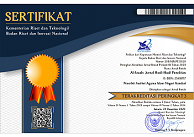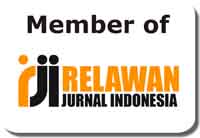Hijrah ke Manhaj Salaf: Ekspresi dan Negoisasi Kesalehan Kaum Muda Urban
Abstract
This article examines the trend of hijrah among young Muslims by taking the case of the participants at the Nurul Iman Mosque, Blok M Square, Jakarta. They actively participate in regular Islamic learning held at the mosque and frame their participation as a form of hijra (migration) to the Salafi path. Our study draws on an anthropological approach by conducting participatory observation and in-depth interview. We explore the young Muslim motivations and initial introduction to Salafism. We examine how they view hijrah and how they practice it in their individual and social lives. The result of this research shows that the Salafi youths view hijrah as a process to become better Muslims. In practice, they have applied the teachings of Salafism in their everyday lives in terms of behaviour, dressing, and interaction. The narrations of the Salafi youths suggest that they have undertaken various forms of negotiations in practicing their hijrah
Keywords
Full Text:
PDFReferences
Akmaliyah, Wahyudi, “The Rise of Cool Ustadz: Preaching, Subcultures, and the Pemuda Hijrah Movement, dalam Norshahril Saat dan Ahmad Najib Burhani (eds.), The New Santri: Challenges to Traditional Religious Authority in Indonesia, Singapore: ISEAS Yusof Ishak Institute, 2018: 239-257.
Bayat, Asef, Life as Politics: How Ordinary People Change the Middle East, Amsterdam: Amsterdam University Press, 2010: 137-160.
-------, Making Islam Democratic: Social Movements and the Post-Islamist Turn, California: Standford University Press, 2007.
Birgit Meyer, “‘Make a Complete Break with the Past’: Memory and Post-Colonial Modernity in Ghanaian Pentecostalist Discourse”, Journal of Religion in Africa vol. 28, no. 3, 1998: 316-349.
Durkheim, Emile, “The Elementary Forms of Religious Life”, dalam M. Lambek (Ed.). A Reader in the Anthropology of Religion, London: Blackwell, 2002: 34-47.
Fadil, Nadia, Rediscovering the “Everyday Muslim”, HAU: Journal of Ethnographic Theory, vol. 5, no. 2, 2015: 59-88.
Haryadi, Didi dan Munandar, Aris, “Tafsir Kesalehan Sosial bagi Anggota Komunitas Hijrah Terang Jakarta dan Shift Bandung”, Jurnal Sosiologi Reflektif, vol. 15, no. 2, 2021.
Hasan, Noorhaidi, Laskar Jihad: Islam, Militancy, and the Quest for Identity in Post-New Order Indonesia. Ithaca: Cornell Southeast Asian Program, 2006.
Haykel, Bernard, “On the Nature of Salafi Thought and Action: Appendix al-Qaeda’s Creed and Path”, dalam Meijer, Global Salafism: Islam’s New Religious Movement, London: Hurst & Company, 2009.
Janson, Marloes, “’How, for God’s Sake, Can I be a Good Muslim?’: Gambian Youth in Search of A Moral Lifestyle”, Ethnography, vol. 17, no. 1, 2016: 23.
Jawas, Yazid bin Abdul Qadir, Mulia dengan Manhaj Salaf, Bogor: Pustaka At-Taqwa, 2020.
-------, Sifat Wudhu dan Shalat Nabi Shallallahu alaihi wa Sallama, Bogor: Pustaka Imam Syafi’i, 2019.
Kloos, David, Becoming Better Muslims: Religious Authority and Ethical Improvement in Aceh, Indonesia, Princeton: Princeton University Press, 2018.
Koning, Martijn de, “’Reaching the Land of Jihad’- Dutch Syria Volunteers, Hijra and Counter-Conduct”, Contemporary Islam, no. 15, 2021: 107-122.
Lofland, John and Stark, Rodney, “Becoming a World-Saver: a Theory of Conversion to a Deviant Perspective”, American Sociological Review, vol. 30, no. 6, 1965.
Mahmood, Saba, Politics of Piety: The Islamic Revival and the Feminist Subject. Princeton: Princeton University Press, 2005.
Masud, Muhammad Khalid, “The Obligation to Migrate: The Doctrine of Hijra in Islamic Law”, dalam Dale F. Eickelman & James Piscatory, Muslim Travellers: Pilgrimage, Migration, and the Religious Imagination, London & New York: Routledge, 1990.
Meijer, Roel (ed.), Global Salafism: Islam’s New Religious Movement, London: Hurst & Company, 2009.
Nisa, Eva, “Embodied Faith: Agency and Obedience among Face-veiled University Students in Indonesia”, The Asia Pacific Journal of Anthropology, Vo. 13, no. 4, 2012, 366-381.
Pusat Penelitian Islam dan Masyarakat (PPIM) UIN Jakarta, Hasil Penelitian Tren Keberagamaan Gerakan Hijrah Kontemporer, https://ppim.uinjkt.ac.id/download/tren-keberagamaan-gerakan-hijrah-kontemporer/, diakses 5 September 2021.
Schielke, Samuli, “Being Good in Ramadan: Ambivalence, Fragmentation, and the Moral Self in the Lives of Young Egyptians”, Journal of the Royal Anthropological Institute, no. 15, 2009: 23-38.
Temby, Quinton, “Shariah, Dakwah, and Rock ‘n’ Roll: Pemuda Hijrah in Bandung “, New Mandala, 30 Juni 2018. Link tersedia di https://www.newmandala.org/shariah-dakwah-rock-n-roll-pemuda-hijrah-bandung/. Diakses pada 10 Agustus 2021.
Vroon-Najem, Vanessa and Annelies Moors, “’Making Hijra’: Mobility, Religion and the Everyday in the Lives of Women Converts to Islam in the Netherlands”, Contemporary Islam, no. 15, 2021.
Wahid, Din, Nurturing the Salafi Manhaj: A Study of Salafi Pesantrens in Contemporary Indonesia, PhD Thesis, Utrecht University, 2014.
DOI: http://dx.doi.org/10.31332/ai.v0i0.3569
Copyright (c) 2022 Syamsul Rijal, Ade Masturi

This work is licensed under a Creative Commons Attribution-NonCommercial-ShareAlike 4.0 International License.










